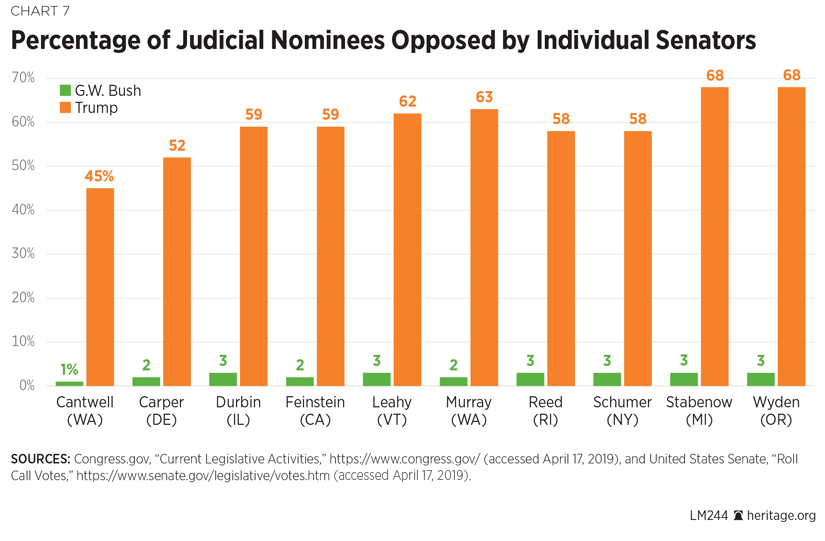Introduction
When the 1787 constitutional convention in Philadelphia concluded, it is said, Benjamin Franklin was asked what type of government they had established, and he replied: “A Republic, if you can keep it.”REF In his 1810 State of the Union Address, President James Madison acknowledged that “a well-instructed people alone can be permanently a free people.”REF In other words, Professor Richard Beeman writes, “democratic republics are not merely founded upon the consent of the people, they are also absolutely dependent upon the active and informed involvement of the people for their continued good health.”REF To that end, this Legal Memorandum provides background on and analysis of federal judicial appointments during the 115th Congress (2017–2018), the first two years of President Donald Trump’s Administration.
America’s Founders designed the judiciary to be the “weakest” and “least dangerous” branch of government.REF As legal commentator Stuart Taylor aptly describes, however, “[l]ike a great, ever-expanding blob, judicial power has insinuated itself into every nook and cranny.”REF Expanding judicial power inevitably increases conflict over judicial appointments.
Because even a two-year period is little more than a snapshot in United States history, it is important to present data regarding the judicial appointment process fairly. Individual data points are important but by themselves can be incomplete or even misleading. This paper avoids this problem in two ways.
- It offers comparative data from the same period during the previous five presidential Administrations, and
- When necessary, it presents data as relevant percentages as well as points.
The Judicial Branch
The Constitution recognizes two categories of federal courts. Article I gives Congress power to “constitute Tribunals inferior to the supreme Court.”REF Article III vests “judicial power” in “one supreme Court and such inferior Courts as the Congress may from time to time ordain and establish.”REF
This paper focuses on Article III courts. In addition to the Supreme Court, the U.S. District Court currently has 663 permanent seatsREF distributed across 94 geographical districts. The U.S. Court of Appeals currently has 179 permanent seats distributed across 12 geographical circuits and one subject-matter circuit. The U.S. Court of International Trade,REF which hears cases involving international trade and customs laws, currently has nine permanent seats.
The Judicial Appointment Process
The Constitution gives to the President power to “nominate, and by and with the Advice and Consent of the Senate, [to] appoint…Judges of the supreme Court, and all other Officers of the United States, whose Appointments are not herein otherwise provided for, and which shall be established by Law.”REF America’s Founders saw the requirement of Senate consent as a “powerful, though, in general, a silent operation.” It would, they thought, be “an excellent check upon a spirit of favoritism in the President, and would tend greatly to prevent the appointment of unfit characters.”REF
The Constitution does not further direct how the President or the Senate must exercise their respective powers in the appointment process. Like the House, the Senate has the power to “determine the Rules of its Proceedings.”REF Senate Rule 31 provides that “[w]hen nominations shall be made by the President of the United States to the Senate, they shall, unless otherwise ordered, be referred to appropriate committees.”REF Nominations to Article III courts are referred to the Judiciary Committee and, if reported to the full Senate, are listed on the Senate’s executive calendar.REF Nominations that are neither confirmed nor rejected during the two-year Congress in which they are made expire and are returned to the President. Judicial nominees confirmed by the Senate take office when they have received their commission and take the oath prescribed by statute.REF
Judicial Vacancies
Background. Judicial vacancies allow new appointments and occur by either creation or attrition. The first judicial vacancies occurred when the Judiciary Act of 1789 created the first 19 judgeships. The 1990 Judicial Improvements Act, the last significant expansion of the judiciary, tripled judicial vacancies by creating 11 new judgeships on the U.S. Court of Appeals and 69 on the U.S. District Court.REF In 2019, the Administrative Office of the U.S. Courts recommended that Congress create five judgeships on the U.S. Court of Appeals for the Ninth Circuit and 65 judgeships on the U.S. District Court across 27 different districts.REF
Most vacancies, however, occur by attrition when judges leave existing judicial positions. Judges on Article III courts have unlimited termsREF and can either leave the judiciary entirely by retiring or resigning or leave their individual judicial position by taking “senior status.”REF Over the past two decades, approximately 40 vacancies have occurred annually through attrition, three-quarters of them by judges taking senior status.
The Administrative Office of the U.S. Courts organizes judicial vacancies into three categories.
- Current vacanciesREF are judicial positions that are empty at a given time.
- Future vacanciesREF exist when a judge has made known that he or she plans to leave, either on a specific date or at a time in the near future such as when a successor is appointed.
- “Judicial emergency” vacanciesREF are designated using a formulaREF that incorporates the longevity of a vacancy and its impact on judicial caseloads. Over the past two decades, an average of 40 percent of current vacancies have been designated as judicial emergencies.
Analysis. Both the 115th Congress and the Trump Administration began in January 2017. Judicial vacancies had more than doubled during the previous two years and, at 106, had reached triple digits for the first time in six years. Vacancies increased during the 114th Congress because, while the number of judgeships remained constant and the attrition rate was stable, the number of confirmations declined to a record low.
The Senate confirmed an average of 87 Article III judges during the final two years of the Administrations of Presidents Ronald Reagan, George H. W. Bush, Bill Clinton, and George W. Bush. To account for Congress creating more than 100 judgeships during this period, the better benchmark is that these Presidents appointed an average of 10.8 percent of the judiciary in their final two years. In contrast, the Senate confirmed only 20 judges during President Barack Obama’s final two years in office. Those 20 confirmations constituted just 2.35 percent of the judiciary, the lowest confirmation level in American history except during the 11th Congress (1809–1810) when no judges were confirmed at all.
As this paper will document, President Trump made nominations and the Senate Judiciary Committee held hearings at a robust pace during the 115th Congress. Despite those efforts, however, vacancies were 26 percent higher at the close of the 115th Congress than they were when President Trump took office. The judiciary is currently in the longest period of triple-digit judicial vacancies since the 1991–1994 period after Congress created 80 new judgeships through the Judicial Improvements Act. Today, 59 percent of current vacancies are judicial emergencies, which is significantly higher than the historical average. Table 1 shows the change in judicial vacancies during the first two years of the past six Administrations.
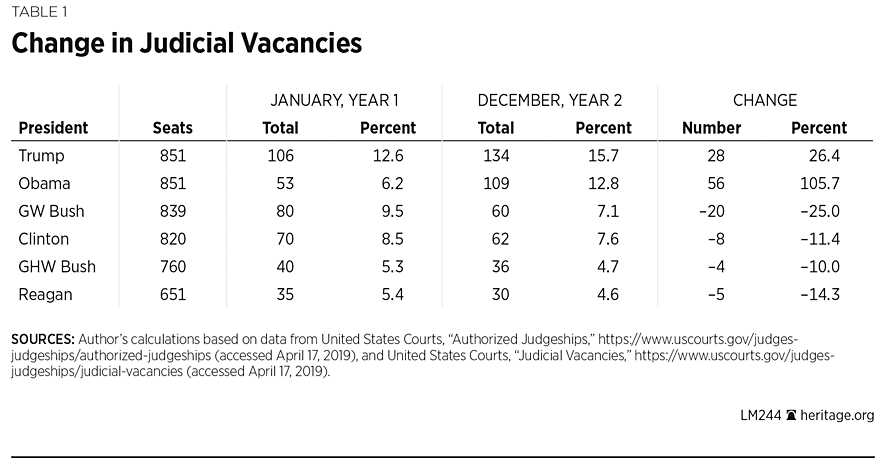
Judicial Nominations
Background. Establishing a nomination infrastructure is only one of many significant tasks for any new presidential Administration. President George H. W. Bush succeeded the President in whose Administration he had served. Much of the Reagan Administration’s nomination infrastructure remained, including identified candidates and actual nominees. As a result, President Bush was able to begin making nominations to the lower federal courts only a month after taking office. His initial nominees to the U.S. District Court and U.S. Court of Appeals had been nominated the previous year by President Reagan.
Like four of his five predecessors, however, President Trump succeeded a President of a different political party. When this happens, the new President must build his entire Administration, including the judicial nomination infrastructure, from scratch. This effort, as well as other policy priorities and the immediate need for Cabinet appointments, can delay and reduce the number of judicial nominations during a new President’s first year.
As noted, the Constitution gives the nomination power to the President but does not direct how he must exercise that power. Judicial attrition makes this one of the few continuous presidential duties, and each President decides the priority, process, and substantive standards to use in making judicial nominations.
Analysis. President Trump began making nominations to inferior Article III courtsREF in March 2017 and maintained a robust pace during his first two years. He made more than twice as many nominations in his first six months and 44 percent more in his first two years than the average for his five predecessors. Table 2 presents each President’s nomination activity during his first two years in office.
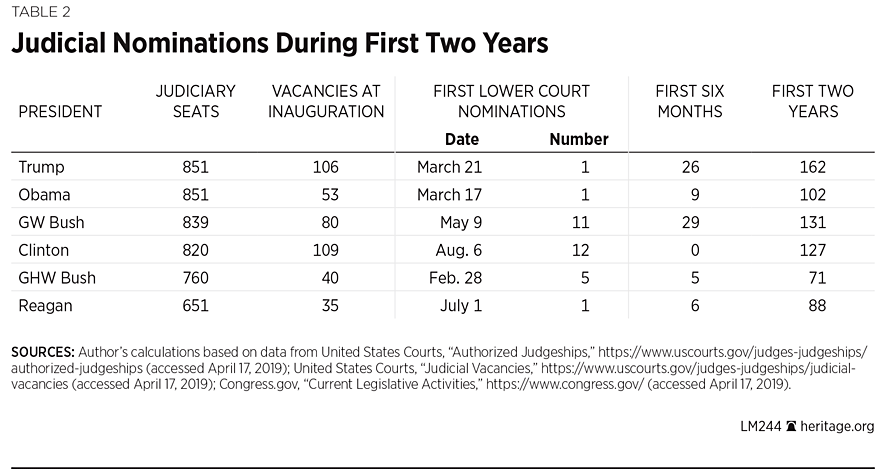
American Bar Association Ratings
Background. The American Bar Association has evaluated and rated potential or actual Article III judicial nominees since the early 1950s. All but two Presidents since then have sought the ABA’s assessment prior to nomination; Presidents George W. Bush and Donald Trump have made nominations without an ABA rating.
Today, the ABA bases its ratings on three criteria: integrity, professional competence, and judicial temperament. The first two are reasonably objective, and judicial temperament is more subjective. The ABA says that judicial temperament includes “the nominee’s compassion, decisiveness, open-mindedness, courtesy, patience, freedom from bias and commitment to equal justice under the law.”REF
The ABA’s 15-member evaluation committee provides three ratings based on these criteria: well qualified, qualified, and not qualified.REF In its publicationsREF and on its website,REF the committee makes clear that its majority rating is the official ABA rating for a nominee.
The ABA’s ratings and the process used to produce them have been controversial for many years. Several academic studies have attempted to determine whether the ABA’s judicial nominee ratings show measurable or systematic partisan bias. In 2001, Professor James Lindgren examined ABA ratings for the 108 judges appointed to the U.S. Court of Appeals by Presidents George H. W. Bush and Bill Clinton.REF Among nominees without prior judicial experience, and controlling for other credentials, Lindgren found that Clinton nominees were at least 10 times more likely to receive a unanimous “well qualified” rating. He also found that the ABA evaluation committee provided a unanimous rating five times more often for Clinton nominees than for Bush nominees.
Also in 2001, American Enterprise Institute scholar John Lott’s analysis included candidates who were not nominated and nominees who were not confirmed.REF He found “some evidence that on average Clinton nominees have been treated more favorably than Bush nominees.” Lott returned to this subject in 2009, examining ABA ratings for nominees to both the district and appeals courts between 1977 and 2004. His study “reveals the ABA as systematically giving lower ratings to Republican circuit court nominees, although no similar bias appears to exist for district court nominees.”REF
Finally, three political scientists studied ABA ratings for nominees to the U.S. Court of Appeals between 1977 and 2008.REF They found “strong evidence of systematic bias in favor of Democratic nominees,”REF concluding that “the ABA’s ratings are systematically lower for Republican nominees than for Democratic nominees, regardless of the broader political environment.”REF
Analysis. Reflecting President Trump’s higher number of nominations, the ABA rated 157 of President Trump’s nominees to the U.S. District Court and U.S. Court of Appeals during his first two years, compared to 101 for President Obama, 130 for President George W. Bush, and 142 for President Clinton.REF Chart 1 presents the percentage of each President’s rated nominees receiving a “well qualified” ABA rating during their first two years.
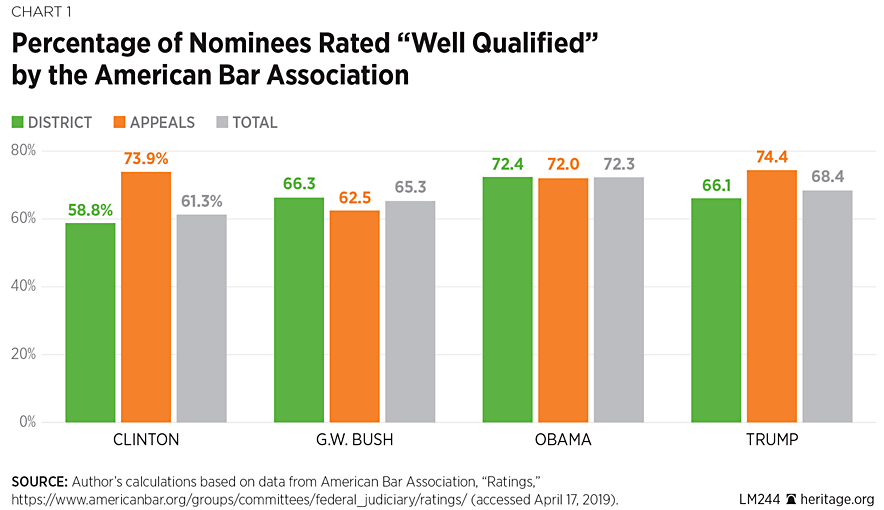
Critics of President Trump’s nominees note that several received a “not qualified” rating from the ABA. The Senate confirmed five of President George W. Bush’s nominees to Article III courts who had received a “not qualified” rating, four by voice vote and one by a 98-to-1 vote. Similarly, the Senate confirmed three of President Clinton’s nominees to Article III courts who had received a “not qualified” rating, all three by voice vote.
Hearings
Background. The chairman of the Senate Judiciary Committee controls the scheduling, composition, and pace of hearings on judicial nominations. The committee’s hearing schedule can vary significantly, depending on such factors as the number of judicial vacancies, the pace and timing of a President’s nominations, the party of the President and the Senate majority, and individual decisions by the committee chairman.
On October 20, 1978, President Jimmy Carter signed into law legislation creating 151 new judgeships. During 1979 alone, led by Chairman Edward Kennedy (D–MA), the Judiciary Committee held a hearing for 139 of Carter’s 152 nominees, and the Senate confirmed 135 of them. Each of these—nominations, hearings, and confirmations—remains an annual record to this day. As a result, only 35 judicial positions, or 5.4 percent of the judiciary, were vacant when President Reagan took office in January 1981.
On December 1, 1990, President George W. Bush signed into law legislation creating 80 new judgeships. During the 102nd Congress (1991–1992), Chairman Joseph Biden (D–DE) refused to give a hearing to more than 50 of President Bush’s nominees. The New York Times reported that “the Democrats who control the Senate have begun to delay confirming some of President Bush’s nominees for major judgeships to preserve the vacancies for Gov. Bill Clinton to fill if he is elected President.”REF As a result, 109 judicial positions, or 13.3 percent of the judiciary, were vacant when President Bill Clinton took office in January 1993.
Another factor that can affect the scheduling of confirmation hearings is the opinion of the Senators from the state in which a judicial nominee would serve. In 1917, Judiciary Committee Chairman Charles Culberson (D–TX) began the practice of inquiring whether these home-state Senators supported or opposed judicial nominees. This practice is often called the “blue slip” courtesy because home-state Senators express their support or opposition on a blue sheet of paper.
Because neither Senate nor Judiciary Committee rules require the blue slip courtesy, each chairman decides whether and how to employ it, and individual Senators decide whether and how the views of home-state colleagues will influence their consideration of judicial nominees. Under all but two chairmen since 1917, for example, the blue slip courtesy has played an “advisory role” for the Judiciary Committee and the Senate.REF Recent chairmen, including Biden, Orrin Hatch (R–UT), and Charles Grassley (R–IA), have emphasized that opposition from home-state Senators will not block a nominee, especially to the U.S. Court of Appeals, if the White House has properly consulted with them before making a nomination.
Analysis. President Trump’s higher number of nominees presented the Judiciary Committee with a significant task. During the first two years of the previous five Administrations, the Senate held an average of 30 hearings for 96 nominees to Article III courts, or an average of 3.2 nominees per hearing. During the 115th Congress, the Judiciary Committee held 33 hearings for a total of 134 nominees to Article III courts, or an average of 4.1 nominees per hearing. Even though the Judiciary Committee in the 115th Congress held a hearing for 40 percent more total nominees than the previous average, this total was only slightly above average as a percentage of the nominations made by those Presidents.
In May 2018, Senate Judiciary Committee Democrats released a report titled Review of Republican Efforts to Stack Federal Courts. The report argues that including in the same hearing more than one nominee to the U.S. Court of Appeals “hampers the ability of senators to adequately vet each nominee.”REF Yet the previous eight chairmen, of both parties, held nearly 50 hearings with multiple appeals court nominees. Edward Kennedy broke the record when he held a hearing on June 25, 1979, for seven nominees to the U.S. Court of Appeals for the Fifth Circuit.
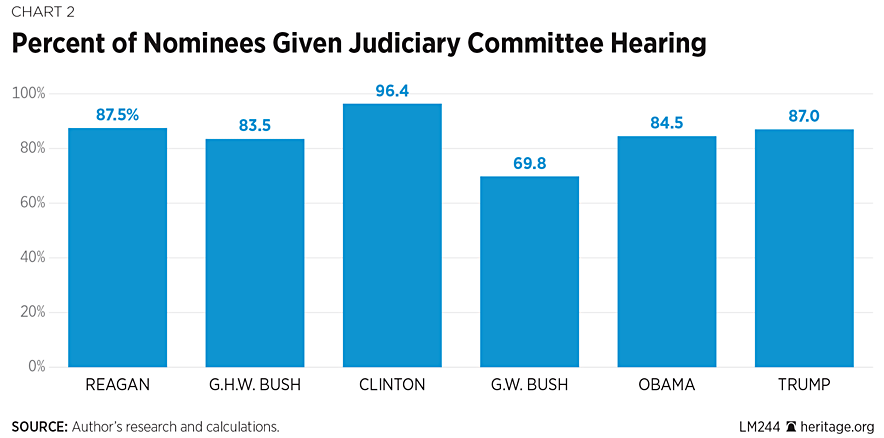
Confirmations
Background. The number of judges confirmed is the most commonly cited judicial appointment statistic and is determined by the number of nominations, the nominees given a hearing and approved by the Judiciary Committee, and the ability of the Senate to confirm nominees. That ability is greatly influenced by the fact that this final phase of the appointment process is the only one that directly involves both political parties. Sitting judges primarily control when vacancies occur by when they choose to leave, Presidents control nominations, and Judiciary Committee chairmen control hearings. When a nomination reaches the full Senate, however, the minority party has several opportunities to influence the number and pace of confirmations. Three of these—cloture votes, post-cloture debate, and roll call votes—are discussed below.
Confirmations can be presented in three ways: as a total during a specific period of time, as a percentage of the President’s nominations during that period, or as a percentage of the permanent seats in the judiciary.
Analysis. During the 115th Congress, the Senate confirmed 53 judges to the U.S. District Court, 30 to the U.S. Court of Appeals, and two to the U.S. Supreme Court. This total of 85 is slightly below the average of 90 during the previous five Presidents’ first two years. This is despite the fact that during the 115th Congress, nominations were 55 percent higher and nominees receiving a hearing were 40 percent higher, than that previous average.
During the 115th Congress, the Senate confirmed 52 percent of President Trump’s judicial nominees, compared to an average of 86 percent for the previous five Presidents. During the 103rd Congress, for example, the Senate confirmed 100 percent of President Clinton’s nominees, but that figure dropped to 71 percent during the 107th Congress, President George W. Bush’s first two years.
Finally, judicial confirmations during the 115th Congress constituted 10 percent of the judiciary, compared to an average of 12 percent during the first two years of the previous five newly elected Presidents. Chart 3 presents the percentage of the judiciary appointed by the previous eight Presidents during their first two years.
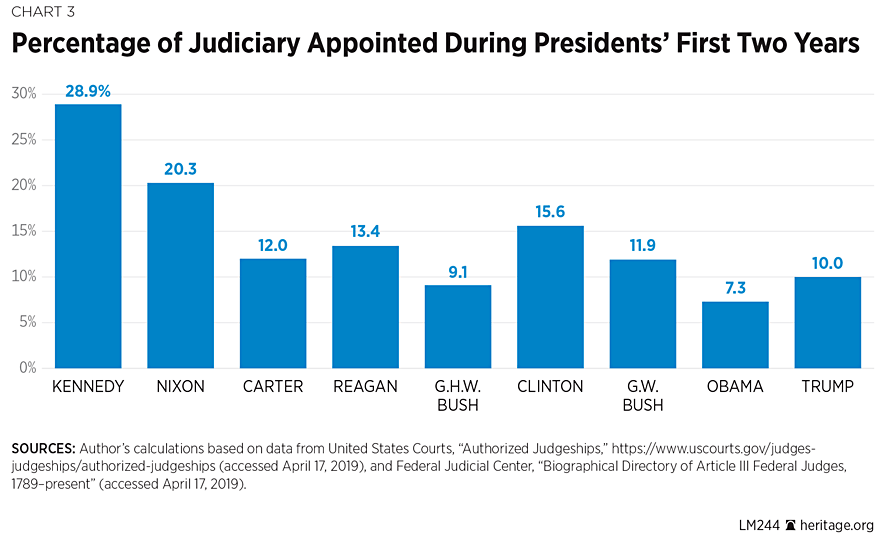
The most significant confirmation progress occurred for nominees to the U.S. Court of Appeals. The Senate confirmed 30 judges, or 16.8 percent of that court, during the 115th Congress. While this is a record total for a new President’s first two years, it is not a record in percentage terms. President Richard Nixon, for example, appointed 20.6 percent of the U.S. Court of Appeals during the 91st Congress (1969–1970), and President John F. Kennedy appointed 21.8 percent during the 87th Congress (1961–1962).
Confirmation Opposition
Background. The best indicator of support or opposition for a judicial nominee, either by the full Senate or by an individual Senator, is the Senate’s final disposition of the nomination. Votes earlier in the process, such as votes to report a nominee from the Judiciary Committee or to invoke cloture, may simply indicate a Senator’s view that the full Senate should consider the nomination. When the full Senate makes its confirmation decision, individual Senators can express support for a nomination either passively by allowing a nomination to be confirmed by unanimous consent without objection or actively by voting in favor of confirmation when a roll call vote is taken.
Analysis. Data regarding confirmation opposition can be presented in different ways. The most general measure is the number or percentage of nominees who received any negative confirmation votes. Using this measure, Chart 4 compares the percentage of judicial nominees confirmed during each President’s first two years with at least one negative vote.
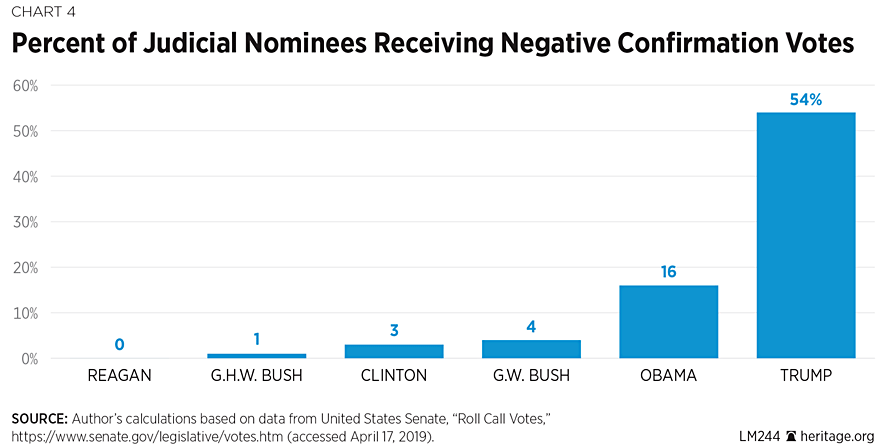
The Senate confirmed a total of 534 Article III judges during the first two years of Presidents Reagan through Trump, and 66 of them received at least one vote against their confirmation. Chart 5 compares each President’s share of the total confirmations and total opposed nominees during his first two years in office. Then, because the broad category of nominees receiving at least one negative confirmation vote can be incomplete, Chart 6 compares the shares of nominees receiving different levels of opposition under these six Presidents.
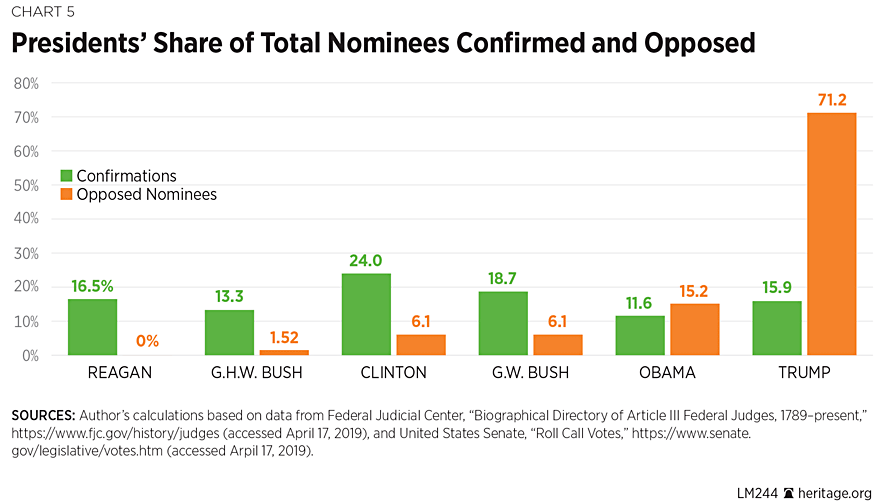
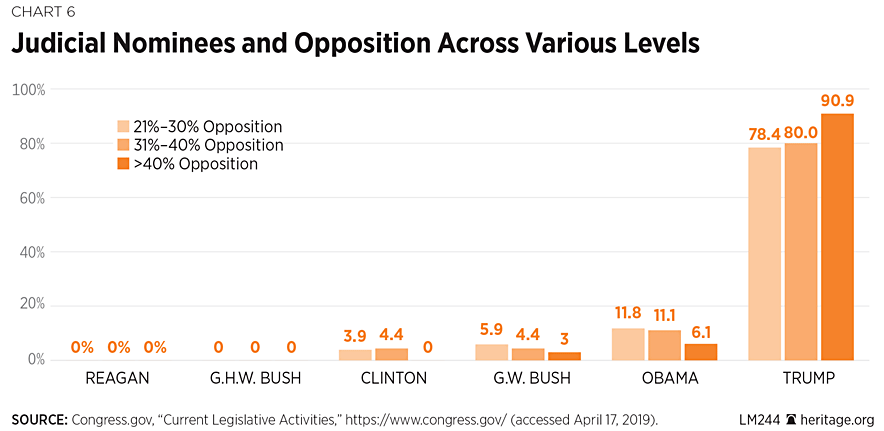
One more comparison dispels the notion that substantial opposition to judicial nominees of the other party is standard confirmation practice. Ten Democrats served in the Senate during the Administrations of both George W. Bush and Donald Trump. During the 103rd Congress (2001–2002), the Senate confirmed 100 judicial nominees and took 59 roll call votes. During the 115th Congress (2017–2018), the Senate confirmed 85 judicial nominees and took 58 roll call votes. As depicted in Chart 1, 65.3 percent of Bush nominees and 68.4 percent of Trump nominees received a rating of “well qualified” from the American Bar Association.
Chart 7 shows the percentage of each President’s nominees that each of these 10 Senators opposed. None of these Democrats opposed more than 3 percent of Bush’s nominees or fewer than 45 percent of Trump’s nominees. On average, they opposed fewer than 3 percent of Bush’s nominees and have opposed 59 percent of Trump’s nominees.
Cloture Votes
Background. The Senate must end debate on a nomination or a bill before it can vote on confirmation or passage. Traditionally, ending debate and scheduling a final vote have occurred informally by agreement between the Senate’s two party leaders. Without that cooperation, ending debate requires the formal process provided by Senate Rule 22. The Senate can vote on a motion to end debate on a nomination or bill two days after it is filed. Rule 22 requires “three-fifths of the Senators duly chosen and sworn,” or 60 votes, to invoke cloture. A filibuster occurs when this attempt to invoke cloture fails. Requiring a supermajority for cloture but a simple majority for confirmation potentially allows a group of Senators who lack the votes to defeat a nomination outright to block confirmation by preventing a final vote altogether.
In 1949, the Senate amended Rule 22 to expand its application from any “measure,” which had been interpreted to exclude motions, to any “matter” before the Senate.REF The broader language also appeared unintentionally to cover nominations, but the Senate did not take a cloture vote on a nomination until 1968REF and did not use the filibuster to defeat a majority-supported judicial nomination until 2003.
On November 21, 2013, the Democrat-controlled Senate voted 52 to 48 to reinterpret “three-fifths” in Rule 22 to mean “simple majority” for all nominations except to the Supreme Court. This effectively abolished nomination filibusters by making the vote threshold for cloture the same as the vote threshold for confirmation.REF As a result, cloture votes can be used today to delay, but not to defeat, a nomination.REF On April 6, 2017, the Republican-controlled Senate voted 52 to 48 to extend this reinterpretation of Rule 22 to Supreme Court nominations.
Analysis. During the 115th Congress, the Senate took 48 cloture votes on nominees to Article III courts, and because of Rule 22’s reinterpretation, each cloture vote passed and each nominee was confirmed. Chart 8 compares this to cloture votes during the first two years of previous Presidents.
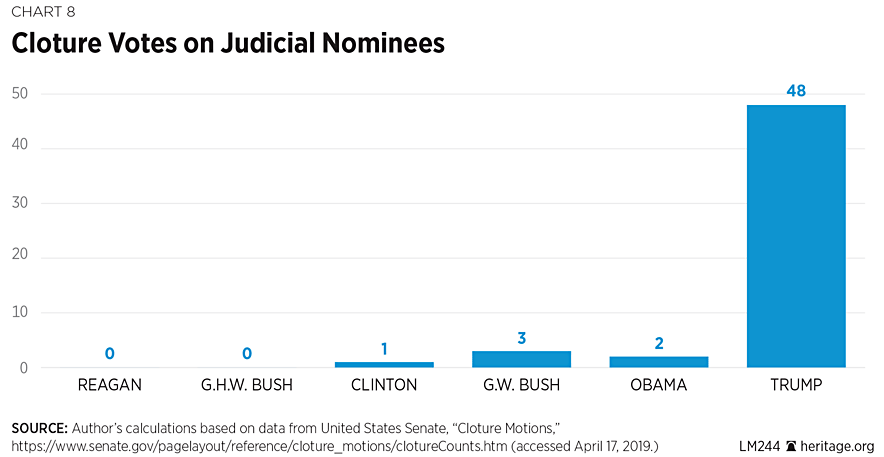
Roll Call Votes
Background. The Senate can approve a nomination with or without a roll call (recorded) vote. Confirming by voice vote or unanimous consent takes only about 30 seconds and does not require the presence of all Senators. A roll call vote takes about 30 minutes and does require the presence of all Senators.
Between 1789 and 2000, from President George Washington to President George W. Bush, the Senate confirmed nearly 3,000 judges to Article III courts. Of these 3,000 judges, 84 (less than 3 percent) were confirmed by roll call votes, and fewer than one-third of those votes were unanimous. The more time-consuming confirmation method was used so that Senators could register opposition to the few genuinely controversial nominees.
During the Bush Administration, the Senate took 192 roll call votes on judicial confirmations—more than three times as many as in the previous two centuries combined—and 176 of those votes were unanimous. The purpose of roll call votes was no longer to allow Senators to register opposition to controversial nominees, but rather to make the judicial confirmation process more time-consuming for all nominees, even those without any opposition at all.
This pattern continued during the Obama Administration, with 69 percent of Obama’s judicial appointments confirmed by roll call vote and 54 percent of those nominees receiving unanimous support. In 2014, the year following Democrats’ reinterpretation of Rule 22 to abolish filibusters, the Senate confirmed 89 judges to Article III courts. Of those 89 judges, 78 percent were confirmed by roll call votes, and 58 percent of those votes were unanimous.
Analysis. During the 115th Congress, the percentage of nominees confirmed to Article III courts by roll call vote remained high at 69 percent, but only 20 percent of those votes were unanimous. The foregoing analysis shows how opposition to Trump’s judicial nominees has far exceeded the opposition to any previous President’s judicial nominees. While roll call votes are unnecessary when no Senators oppose a nominee, they are the only way for Senators to express their opposition publicly.
Conclusion
This Legal Memorandum has presented data and analysis about appointments to Article III federal courts during the 115th Congress. The evidence presented shows that, compared to the first two years of President Trump’s five predecessors:
- Vacancies on Article III courts were higher when President Trump took office and increased by 26 percent.
- President Trump made 55 percent more nominations during his first two years.
- President Trump’s judicial nominees received comparable or better ratings from the American Bar Association.
- The Judiciary Committee held a hearing for 40 percent more of President Trump’s nominees.
- The Senate confirmed 52 percent of President Trump’s nominees, compared to an average of 86 percent.
- President Trump’s nominees constitute 16 percent of those confirmed during 1981–2018, but 80 percent of those receiving at least 30 percent opposition.
- The Senate took a cloture vote on 55 percent of President Trump’s confirmed judges, compared to an average of 1 percent.
- The Senate took a roll call vote on 69 percent of President Trump’s confirmed judges, compared to an average of 24 percent.
—Thomas Jipping is Deputy Director of and a Senior Legal Fellow in the Edwin Meese III Center for Legal and Judicial Studies, of the Institute for Constitutional Government, at The Heritage Foundation.

